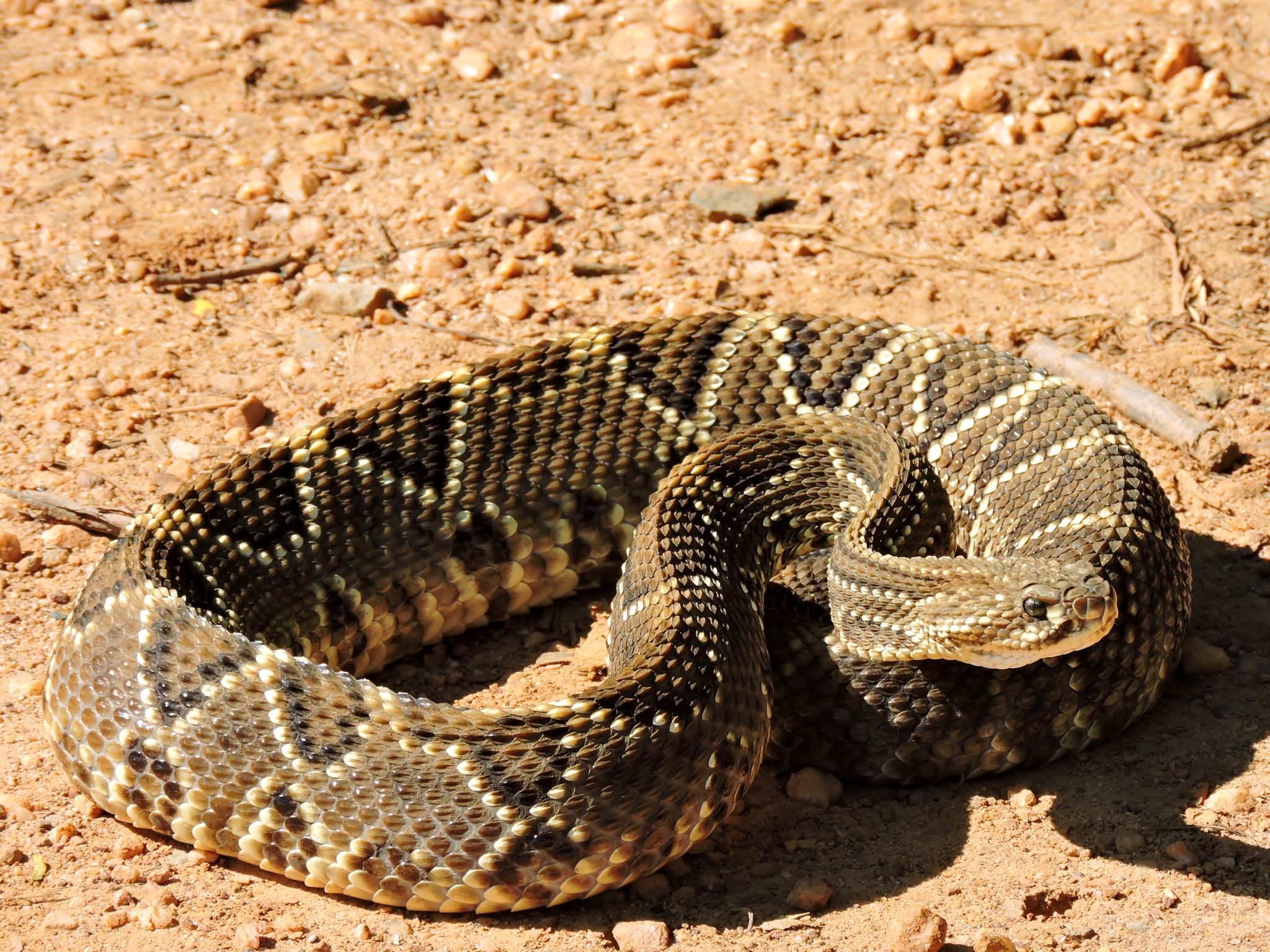The rattlesnake received its name from the rattle located at the end of its tails, which makes a loud rattling noise when vibrated. That rattling noise deters predators or serves as a warning to passers-by. Although these snakes are venomous, they rarely bite unless provoked or threatened and if treated promptly, the bites are seldom fatal. Rattlesnakes are of the genera Crotalus and Sistrurus of the subfamily Crotalinae (the pit vipers). The name Sistrurus is the Latinized form of the Greek word for “tail rattler” and shares its root with the ancient Egyptian musical instrument the sistrum, a type of rattle. This article will give further details about this fascinating snake.
Features Of The Rattlesnake
- Length – The rattlesnake (Crotalus durissus) grows to a length of 1.5 m (4.9 ft), and rarely to a maximum length of 1.9 m (6.2 ft).
- Color – It has two distinct stripes starting at the base of the head. Within the lines, the color is lighter than the stripes.
- Eyes – Their eyes contain a large number of rod cells and are well adapted to nocturnal use. However, rattlesnakes are not exclusively nocturnal, and their vision is more acute during daylight conditions. They also possess cone cells, which means they are capable of some form of color vision.
- Heat-sensing Pits – Aside from their eyes, rattlesnakes are able to detect thermal radiation emitted by warm-blooded organisms in their environment. Functioning optically like a pinhole camera eye, thermal radiation in the form of infrared light passes through the opening of the pit and strikes the pit membrane located in the back wall, warming this part of the organ. Due to the high density of heat-sensitive receptors innervating this membrane, the rattlesnake can detect temperature changes of 0.003 °C or less in its immediate surroundings. Infrared cues from these receptors are transmitted to the brain by the trigeminal nerve, where they are used to create thermal maps of the snake’s surroundings.
- Smell – These snakes have an exceptionally keen sense of smell. They can sense olfactory stimuli both through their nostrils and by flicking their tongues, which carry scent-bearing particles to the Jacobson’s organs in the roof of their mouths.
- Hearing – Like all snakes, rattlesnakes lack external ear openings, and the structures of their middle ear are not as highly specialized as those of other vertebrates, such as mammals. Thus, their sense of hearing is not very effective, but they are capable of sensing vibrations in the ground, passed by the skeleton to the auditory nerve.
- Tail – One of the differentiating features of males and females is the males have thicker and longer tails (because they contain the inverted hemipenes). Also, the tails of males taper gradually from the body, whereas the tails of females narrow abruptly at the vent.
- Fangs – The fangs are connected by venom ducts to large venom glands near the outer edge of the upper jaw, towards the rear of the head. When the rattlesnake bites, muscles on the sides of the venom glands contract, which squeezes the venom through the ducts and into the fangs. When the fangs are not in use, they remain folded against the palate. Rattlesnakes are born with fully functioning fangs and venom, and are capable of killing prey at birth. Adult rattlesnakes shed their fangs every 6–10 weeks. At least three pairs of replacement fangs lie behind the functional pair.
Five Facts About The Rattle
- The rattle serves as a warning for predators of the rattlesnake and is composed of a series of hollow, interlocked segments made of keratin, which are created by modifying the scales that cover the tip of the tail.
- The contraction of special “shaker” muscles in the tail causes these segments to vibrate against one another, making the rattling noise (which is amplified because the segments are hollow) in a behavior known as tail vibration.
- The muscles that cause the rattle to shake are some of the fastest known, firing 50 times per second on average, sustained for up to three hours.
- A new rattle segment is added each time the snake sheds its skin, and the snake may shed its skin several times a year, depending on food supply and growth rate.
- Rattlesnakes travel with their rattles held up to protect them from damage, but in spite of this precaution, their day-to-day activities in the wild still cause them to regularly break off end segments.
Scientific Classification Of The Rattlesnake
Rattlesnake – Crotalus durissus [Scientific name]
- Kingdom: Animalia
- Phylum: Chordata
- Class: Reptilia
- Order: Squamata
- Suborder: Serpentes
- Family: Viperidae
- Genus: Crotalus
- Species: C. durissus
Habitat Of The Rattlesnake
The rattlesnake (Crotalus durissus) is found in South America except the Andes Mountains. However, its range is discontinuous, with many isolated populations in northern South America, including Colombia, Venezuela, Guyana, Suriname, French Guiana and northern Brazil. It prefers savanna and semi-arid zones. It has been reported to occur in littoral xerophilous scrub, psammophilous and halophilous littoral grassland, thorny xerophilous scrub, tropophilous deciduous and semideciduous scrub, as well as tropophilous semideciduous seasonal forest in the northwest of Venezuela. In Guyana, they can be found in the Rupununi Savannah.
Diet Of The Rattlesnake
Rattlesnakes consume mice, rats, small birds, and other small animals. They lie in wait for their prey, or hunt for it in holes. The prey is killed quickly with a venomous bite as opposed to constriction. If the bitten prey moves away before dying, the rattlesnake can follow it by its scent. When it locates the fallen prey, it checks for signs of life by prodding with its snout, flicking its tongue, and using its sense of smell.
Reproduction Of The Rattlesnake
Most rattlesnakes mate during the summer or fall, while some mate only in the spring, or during both the spring and fall. Females secrete small amounts of sex pheromones, which leave a trail the males follow using their tongues and Jacobson’s organs as guides. Once a receptive female has been located, the male often spends several days following her around (a behavior not common outside of the mating season), frequently touching and rubbing her in an attempt to stimulate her. Rattlesnakes generally take several years to mature, and females usually reproduce only once every three years.
Rattlesnakes In Guyana
The rattlesnake is indeed a unique snake with distinct features. Some of the most appealing features are its heat-sensing pits, the fangs, the way they mate and hunt for prey. One of the most feared things about this snake is its venom. So, try to avoid being bitten. Rattlesnakes tend to avoid wide-open spaces where they cannot hide from predators, and generally avoid humans if they are aware of their approach. Remember, they rarely bite unless they feel threatened or provoked. Around half of bites occur in cases where the victim saw the snake, yet made no effort to move away. Caution is advised even when snakes are believed to be dead; rattlesnake heads can see, flick the tongue, and inflict venomous bites for up to an hour after being severed from the body.
Article References:
- https://www.stabroeknews.com/2014/05/04/features/rupununi-rattlesnake/
- http://guyanachronicle.com/2017/06/25/snake-snake
- https://en.wikipedia.org/wiki/Crotalus_durissus
- https://en.wikipedia.org/wiki/Rattlesnake
- Main Image: https://static.inaturalist.org







